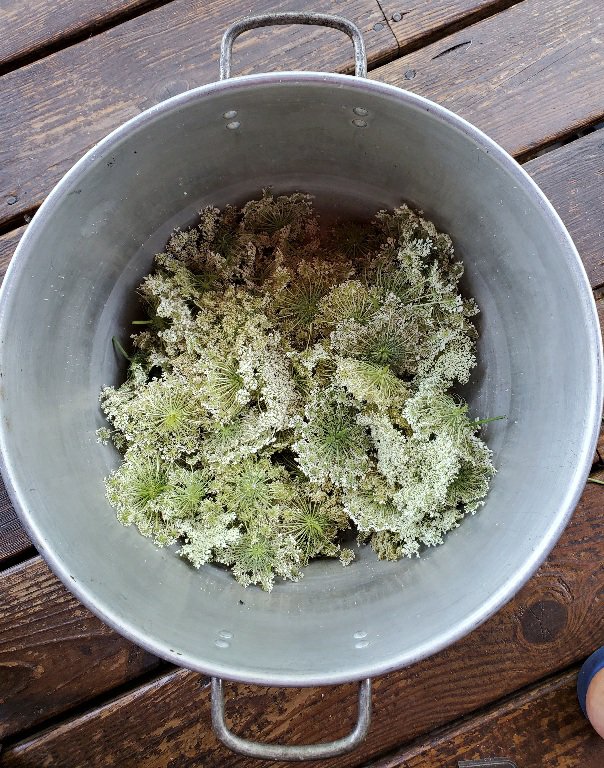I have been taking a lot walks to find plants to make more ink. This time of year there are so may things to choose from. In July I decided on wild bergamot, Queen Anne’s lace and a few day lilies I still had growing in my garden.

Wild Bergamot 
Bergamot ready to cook 
Queen Anne’s Lace ready to steep 
Queen Anne’s Lace
I use wild bergamot to make infused vinagar (btw it’s really delicious) it causes the vinagar to turn a pinkish color so I hoped it would work for ink, Queen Anne’s lace is known in the natural dye world to make a beautiful yellow. The Manhatten day lilies are much darker in color than the first ones I tried in June and I really wanted to see what color I would get if I didn’t burn the lily tea to a crisp.

Bergamot cooking 
Bergamot being reduced after being strained 
Queen Anne’s Lace cooking slow and low 
Day lilies cooking 
The stove with all my experiments 
Sterilizing the bottles and caps
When I had all the plants cooking on low heat I took the new bottles I finally got in the mail and sterilized them, then put the out in the sun to dry.
The Queen Anne’s Lace came out a beautiful orange but when tested on a paper test strip showed up as a very cool yellow. I made enough to try it as a dye pot rather than cooking it down to an ink.
The bergamot was a pretty pink in the pot but never reduced enough to concentrate the color and had this very strange white protein floating around in it when it was heated which disappeared when it cooled off. It never became dark enough to see on a test strip.
The most successful of the 3 was the day lily. It became a rich red/ purple color and I was able to cook it down to the consistency of ink. I took a few test strips of it and placed them aside and then made a couple of bottles of the ink. The following day I looked at the test strips and saw that the color had turned green! and it is a really beautiful green. I am still trying to figure out whether it’s the paper that’s making the color turn or whether it’s just oxidation.


Day lily ink being filtered second time 
sediment from day lily

All I know is that the process is magical and I am enamored with.
Next on my list will be to try dying cloth in the dye pot of Queen Anne’s lace and see how that works..


Amazing!! wow I love that you explore all the possibilities to further your art-your creativeness! much Love Delfin
LikeLike
Please can you say which Queen Anne’s Lace do you mean?
Daucus carota, especially the flowering part of the plant.
Ammi majus (false Queen Anne’s lace), native to the Nile River Valley, with white lace-like flower clusters.
Or:
Anthriscus sylvestris (cow parsley), a herbaceous biennial or short-lived perennial plant in the family Apiaceae?
I would very much like to know.
I have been making a few inks from things in my garden and would love to add Queen Anne’s Lace to my colours.
Yours
Fran Baker
LikeLike
I am not sure of the latin name, it’s probably the first one, Daucus carota
. It grows all over the fields and roadsides her in upstate NY. I use the flower heads for making the dye color. There are a lot of wonderful recipes online if you want to know more.
LikeLike